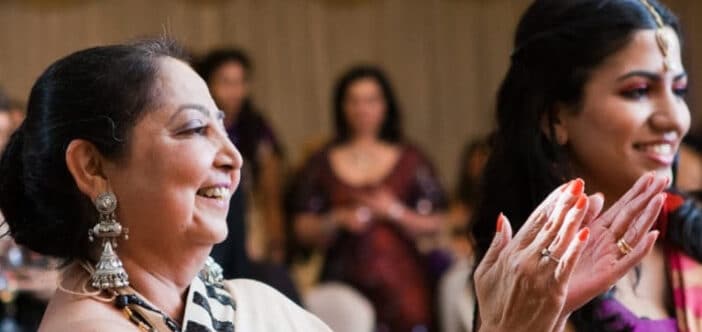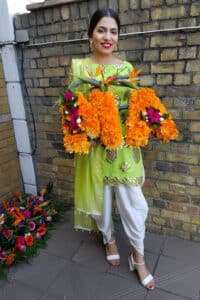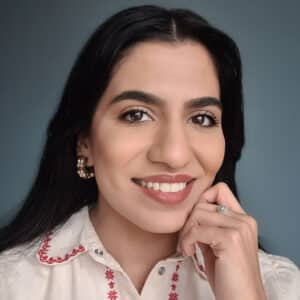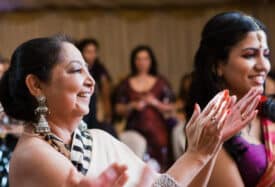A Colourful Death

Photograph: Saijal Reahal with her mother, Bina
Saijal Reahal talks us through her struggle to come to terms with having a chronically ill mother and her visualisations and notions about death, versus those of people around her.
I was nine years old on my school sports day when I discovered my mum had an incurable autoimmune disease that she had kept from me since I was born. I only found out because I was crying that she was the only mum in my friendship group who did not volunteer to participate in the parents’ sack race (horrific, I know). She wiped my tears and said, “I’ll tell you later”.
At home, I learnt that it was lupus, and not lack of love, that made her think twice before throwing her delicate bones around.
I was heartbroken. I couldn’t fathom that an illness had rattled her bones, joints and several organs, that she felt fatigued most days, that it wasn’t safe for her to deliver a baby, and that in spite of all of this, she had barely told a soul, including me.
The day after, I envisioned her funeral. I fired out questions that were only permissible to be asked by a child: “Are you going to die?” “Will I get it and also die?” “How will Papa cope without you?” His cooking skills were, after all, only average at the time.
We created an environment where it was safe to speak about death, with hope, lightness and even humour.Saijal Reahal
Over the years, I was repeatedly reassured. Whilst some days were tough for me, as an only child, and Papa, the strong medications meant Mum could enjoy a good quality of life, her attitude made her consider it a great quality of life… and Papa got better at cooking. We created an environment where it was safe to speak about death, with hope, lightness and even humour. I asked Mum how she would want her send-off to be to the level of detail of: casket open or closed, commiseration or celebration, and which one of her lipsticks I would wear.
The day she passed away at 61, 17 years after that sports day, was still unexpected. She complained of a more intense type of pain in the morning, and within a few hours she was gone. Given the way her illness had worked in the past, with good periods and bad periods, we thought we would get a bit more notice. But, I did feel like I had braced myself for losing her from all of our conversations, post-sack race. I focused my efforts on organising the funeral to do her justice. I would stick to our traditions as British Indian Sikhs, whilst making it colourful, majestic and different, to match her vibrant character.
However, support was not easy to garner from all family and friends. Some were sceptical about doing things in such an upbeat manner. They were not comfortable with the idea of wearing colour or bright lipstick as some of my cousins and I had planned to do in honour of Mum’s style. Having the casket closed also sparked some controversy; I got advised it may be seen as “exclusionary”. And I was told I was probably in shock or denial, especially as I had not cried after the initial 10-minute shock. I came to learn that I was not grieving the traditional way.
I believe talking about life, death and all the ugly bits in between, made coping with both a chronically ill family member and bereavement, easier.Saijal Reahal
Across much of Indian culture, when someone dies, people will arrive almost immediately at the home to pay their respects. And when I say people, I mean everyone the deceased may have ever spoken to, even if they have not seen them in decades. Here, they will pray, talk and eat. This can go on for close to 24 hours a day until the funeral. Luckily, my aunties pretty much moved in and were resident chefs and chaiwalas, catering for the masses of guests and keeping everything spotless. The support of the community was beautiful and a testament to Mum’s people-adoring persona, but nobody prepares you for the gaping hole it leaves when everyone packs up and goes the day after the funeral.
It is also the norm for people to visibly exhibit that they are mourning – that equals showing face at the house, not wearing colour, weeping and even wailing. I found this hard to come to terms with, particularly with those who who were not close to Mum. The Sikh religion does not advocate the need for public, ritualised displays of mourning and, actually, encourages releasing yourself from your interpersonal attachments and letting the deceased go with dignity and good blessings for wherever their soul travels to next. Yet, it seems to be hard for people to break centuries-old “traditions”.

Over the course of the funeral planning to the day itself (which was exactly as splendid as I had wished for Mum), people became more relaxed and open-minded, myself included; after all, there is no right way to grieve. I think their initial discomfort stemmed from death still being a taboo in our culture, and wider society, until it happens – then everyone wants to know and be involved. I was able to talk about death and what happens next relatively freely in my household, but it can be considered morbid, inappropriate, improper.
I also reflected inwards. Perhaps my lack of tears was not so noble. I tried to show I was doing OK. I could not stand people vocalising their pity for losing my mother suddenly, especially at a younger age, when I was navigating my troublesome twenties and did not have a family of my own. My pride was reflective of Mum’s. She fought lupus for over 40 years but kept it a secret that she shared with very few people. I often encouraged her to blog about her experience from the lens of a South Asian sufferer, particularly as she had a science background and a PhD, but she refused. Neither of us, in times of physical or mental pain, wanted to appear weak and risk being gossiped about in the community. Being this vulnerable now is certainly daunting.
But, I believe talking about life, death and all the ugly bits in between, made coping with both a chronically ill family member and bereavement, easier. I have fond memories of Mum and I nattering away about her “loopy lupus”, the bruises she would get after blood tests and injections (“What’s this a map of, Mum?”) and that infamous sack race that changed the course of our mother-daughter dialogue forever.
Mum taught me that death is not the opposite of life; it is the consequence of life – of having breathed, experienced, felt and loved.
You can find more about Saijal’s story in Letters from the Grief Club, an anthology of short works from people who have been bereaved.

Saijal Reahal is a part-time Financial Services consultant and a full-time mental health advocate who has publicly spoken and written about her experiences with depression, trauma and grieving, and how she uses fashion and performance to heal herself. In 2019, Saijal lost her mother to complications of systemic lupus erythematosus, an autoimmune disease she had been suffering from for over 40 years. Through her writing, Saijal seeks to destigmatise and put some colour around chronic illness and death.
- Email: [email protected]
- Instagram: @page_of_saij
There’s much more to death than we think; what if it isn’t just an ending, but an event we can plan for? Thinking beyond the four walls of hospices and hospitals, we have the chance to approach it with confidence and plan a good death. After Wards is a collection of insights and ideas from people who can help us all to re-imagine this essential part of life, and to live well until we die.
Continue the conversation at our Time to Talk events with film screenings, poetry readings, Death Cafes and much more.


